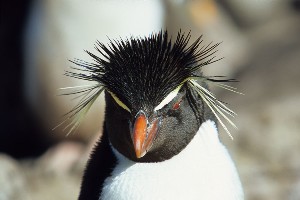
Rockhopper Penguin |
 |
Specific Name: Eudyptes chrysocome |
| Adult Height: 45-58cm | |
| Adult Weight: 2.5-3.5kg | |
| Adult Flipper Length: 15-19cm | |
| Estimated Population: 3.6 Million |
Distribution: |
(Map under construction) | |
Rockhopper penguins breed on many subantarctic and southern temperate zone islands aswell as the S Islands of Argentina.Subspecies are recognized and the Amsterdam and St Paul Island subspecies is now recognized by many as a species in its own right. Subspecies are the Short-Crested Rockhopper (E. c. chrysocome), Eastern Rockhopper (E. c. filholi) and Long-crested or Amsterdam and St Paul Rockhopper (E. c. moseleyi / E. moseleyi (if species status recognized)). These three types are found in (i) Falkland isl. and Cape Horn Archipelago, (ii) P Edward, Marion, Crozet, Kerguelen, Macquarie, Heard, Auckland, Campbell, Antipodes and Bounty islands, and (iii) Tristan da Cunha, Gough, Amsterdam & St Paul islands, respectively. |
||
Feeding: |
Magellanic penguins feed on a variety of organisms such as small fish (e.g. anchovies), cephalopods (e.g. squids) and crustaceans (e.g. krill). The diet at any particular location and time reflects fluctuations in food availability. Fish are the most abundant prey during the breeding season. When food is plentiful near the colony, fishing is usually a daytime activity within around 30km of the coast with penguins returning to land in the late afternoon. However, birds may stay at sea for several days at a time. Magellanic Penguins tend to hunt near the surface and can do so cooperatively in small groups of birds. The birds can herd schools of fish and then seize and swallow these. Sometimes large numbers of these penguins can be encountered in areas with high prey density. Cooperative hunting is however not seen with larger groups of birds. If necessary these birds can fish up to several hundred kilometers offshore, yet this is unusual and indicative of food shortage closer to the colony. Magellanic penguins can dive up to 100m although rarely venture below a depth of 50m under normal circumstances. |
Reproduction: |
||||
Magellanic penguins, unlike all of their spheniscid relatives, only attempt to breed once every year. The male returns to the colony to reclaim its usual burrow with the female returning later. Breeding tends to be with the same partner as in previous seasons and begins in September-October, depending on the longitude of the colony. Simple nests are built in burrows or small pits (often under bushes or betwen rocks) and 2 similar-sized eggs are layed within a period of 3-4 days. Incubation takes approx. 40 days. After hatching, chicks remain on the nest until fledging, which can take from as little as 9 to as long as 17 weeks depending on food abundance. Mortality of the 2nd chick is higher and the first chick tends to be favoured by the parents, especially when food is limited.
|
General Behaviour: |
|||
| |||
Threats: |
Where To See: |
 |
|
Magellanic Penguin with chick. Falkland Islands. |
new |
 |
 |
|
new |
new |
new |